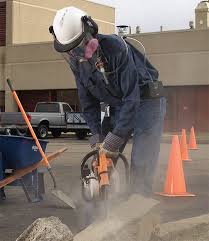How To Prevent Silicosis for Home Builders
Installing custom countertops, sinks, and backsplashes involves working with engineered and natural stones like marble and granite. These jobs could increase the risk of silicosis, a lung disease caused by inhaling silica dust found in stone. Here is what you need to know about protecting builders from lung disease and complications:
Awareness Programs
Countertop fabricators cut, sand, and polish stone slabs. This releases stone particles, also called silica dust, which can be inhaled, causing scarred lung tissue. If not treated, prolonged exposure to silica dust may reduce lung function and lead to further complications. This type of fibrosis is called silicosis.
Training programs for homebuilders help raise awareness of the occupational risks of stone cutting, grinding, polishing, and fabrication. These programs can include proper use of personal protective equipment (PPE), such as respirators and clothing that minimizes dust contact with the skin. They may include information about potential health effects, symptoms, and prevention strategies. Awareness programs help your team work safely and make workplace adjustments to prevent health complications. Availability of the required PPE will also help prevent workers from contracting silicosis.
Prevention Strategies
Some lung complications are preventable with the help of implementing controls and precautionary work practices. Leading stone fabrication companies offer builder onboarding processes that address these aspects. Engineering controls like wet-cutting methods help reduce dust generation by applying water to the stone while cutting. Installing local exhaust ventilation systems at dust sources reduces direct exposure. Certain respirators may prevent accidental inhalation, while protective workwear minimizes dust contact with skin, and work goggles prevent eye contact. Homebuilders should develop comprehensive safety protocols, including mandatory use of PPE, regularly cleaning work areas, and monitoring silica levels. Such measures reduce dust buildup while identifying and enclosing areas of high exposure.
Other strategies include adding a barrier around the stone-cutting site. This could be plastic or a tarp. This helps keep dust in one area, making cleanup more convenient and minimizing contamination. When cleaning dust, use a wet method rather than sweeping, which can make dust airborne.
Medical Surveillance if Exposed
Silicosis can cause shortness of breath, coughing, and weakness. Early recognition of these symptoms can help prevent further damage through medical intervention. Medical monitoring of workers exposed to silica can help identify the condition before it worsens. Workers should report health concerns and symptoms to supervisors and healthcare providers. Open communication and reporting protocols allow you to address concerns before they cause health issues.
Regulatory Compliance
Adhering to safety guidelines from stone fabrication companies and other entities can help reduce exposure to harmful dust. Review permissible exposure limits and comply with all regulations and mandates to create a safe work environment for stone cutters. Onboarding sessions help verify that stone fabricators and other worksite personnel follow the established guidelines. Cutting and grinding stones at dedicated facilities may help reduce exposure to other workers at the building site.
Start Protecting Workers From Silicosis Today
Working with natural and engineered stones with high silica content leaves you vulnerable to inhaling harmful dust. You can establish safety measures to reduce the risk of health issues associated with fabricating stones. Start protecting your workers from silicosis today using high-quality, high-performance products from experienced stone fabrication workers.





![myrkgard stronghold walls came tumbling down]](https://www.waymarketplace.com/wp-content/uploads/2025/02/myrkgard-stronghold-walls-came-tumbling-down-768x389.png)
